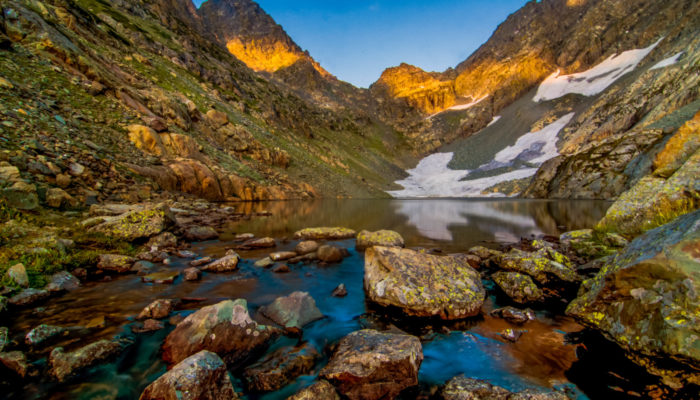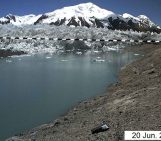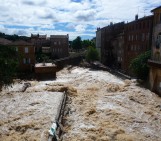
Glacial lake outburst floods are among the most concerning consequences of retreating glaciers in mountain ranges around the world. Although the phenomenon isn’t a new one, it has increasingly become the focus of research efforts in the last two decades, with many scientists seeing these floods as an emblematic symptom of climate change.
This blog sheds some light on this lesser-known geological event, summarizing learnings from a recent paper published in the European Geosciences Union’s open access journal Natural Hazards and Earth System Sciences. It also includes takeaways from the first ever Glacial Lake Outburst Flood conference (July 2021) co-organized by the University of Graz (Austria), the University of Potsdam (Germany), the University of Zurich (Switzerland) and the University of Oregon (USA).
What is a glacial lake outburst flood?
Since the early 20th century, thousands of glacier lakes have been forming behind natural dams in high mountains following glacier retreat. Researchers found that some of these lakes abruptly released pulses of water and sediment with disastrous downstream consequences. This abrupt release came to be called a glacial lake outburst flood: a low-frequency, high-magnitude event with major geomorphic consequences.
Other researchers have described these floods as having “extreme hydrological characteristics” with “possibly adverse impacts on societies.” Some studies explain the onset of glacial lake outburst floods caused by the failure of moraine dams, whose formation and resulting flood involve the process of thinning, flow stagnation and glacier recession. Moraines often contain a melting ice core built from transported rock debris, and when they fail, they release large volumes of stored water that cause flooding.
More than 2800 glacial lake outburst floods have been observed globally till date, and over 12,000 deaths attributed to them. Central Asia appears to be the most affected, followed by South America, the European Alps, Iceland, Scandinavia, north-west America and Greenland.
What makes a lake susceptible to outburst?
A key issue surrounding these floods is the ability to choose the right indicators to predict such an event and determine regions that are vulnerable to sudden flooding. Unfortunately, this is an area of study still very much in its nascent stages. According to the authors, the selection of susceptibility indicators relies on an expert-based analytical hierarchy process with subjectively defined or adopted thresholds, while statistic-based studies that build on rigorous analysis of previous floods are rare. For a given lake, characterizing the current conditions and those prior to outburst remains challenging, which only stresses the need for comprehensive regional lake inventories and lake evolution studies.
But new research is already reshaping our understanding of these ‘outburst triggers’. For instance, although earlier studies considered earthquakes as possible triggers, recent studies have shown that very few glacial lake outburst floods were actually triggered by earthquakes globally. Rapid lake growth is another frequently used susceptibility indicator, but a 2021 study showed that this may not be true in the case of such floods in the Himalayas.
Is there a link to climate change?
A particularly debated question is whether anthropogenic climate change causes glacial lake outburst floods and, if so, to what extent. As of now, the jury is still out on this supposed link. The hypothesis is based on the climate-driven retreat of glaciers that began in the European Alps in the 1850s, and a few decades later in other mountain regions.
Rising air temperatures could change the meltwater input to lakes, and so increase glacier lake volume, given a suitable geometry of the newly exposed basin. At the same time, increasing urbanization, land and water demand, migration, mountain tourism, and other human-related forces have been found to exacerbate human exposure and raise vulnerabilities to these floods, especially in low-income countries.
A 2020 study that investigated a glacial lake outburst flood in the Andes of Peru established “clear causality” from greenhouse gas emissions to glacier shrinkage, lake growth and formation and, possibly, to the ice hazard. Researchers found that an anthropogenic signal from flood risk to greenhouse gas emissions was in fact, traceable. Additionally, they explained that flood risk has been strongly shaped (and increased) by interacting socioeconomic, institutional, and cultural processes over the past few decades.

Geographical focus of research appears to be driven by potential societal impacts and relevance of glacial lake outburst floods and the size of these mountain regions, rather than by the physical flood processes themselves.
Are some communities more at risk than others?
Local communities living near glaciers are most vulnerable to these floods. But it is not just their physical proximity to ice that makes them susceptible – mountain communities are often distant from cities and centres of power, making them politically marginalized and neglected when it comes to infrastructure, hazard mitigation, government assistance, health care, education and economic investment.
This is why current research must recognize the need to work with communities, co-produce knowledge and co-manage landscapes. At the same time, more attention needs to be paid to the ways in which different researchers and stakeholders fundamentally define the glacial lake outburst flood problem and their means to address it – and this must be done involving local communities right from the outset.
Improving risk management takes a village
The authors advocate involvement of local researchers, communities, decision-makers, authorities and other stakeholders to promote diverse knowledge co-production and experience exchange – both of which are fundamental for the consideration, acceptance and utilization of glacial flood research outcomes and improved risk management.
They say there are three key emerging trends that could be engaged and expanded:
- Glacial lake outburst flood contexts, particularly for people living near glaciers
- Flood governance and the broadening of stakeholders involved in prevention, risk reduction and management
- Better understanding of glacial lake outburst flood attribution to pinpoint whether anthropogenic climate change affects its risk and to explore how different social groups understand cause–effect related to these floods
Countries would also do well to foster interdisciplinary cooperation and employ holistic approaches to identify diverse drivers of glacial lake outburst flood risk. Much more research is needed in every direction to better manage this ice hazard and prevent its devastating societal impact.
Further reading on EGU blogs:
Image of the Week – Yes, you’re looking at one of Peru’s most dangerous glacial lakes!
Geosciences Column: Predicting glacial lake outburst floods
Geosciences Column: Getting a handle on glacial lakes
The physical and social changes facing the mountainous populations of the Karakoram Range




